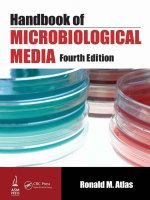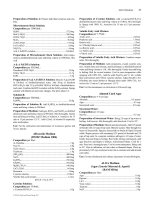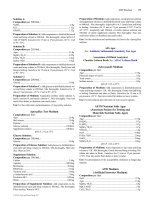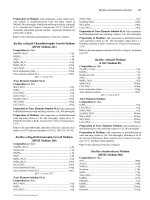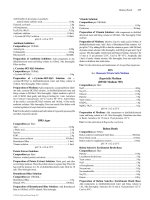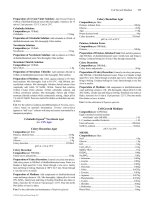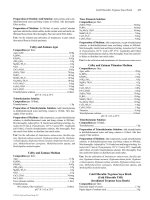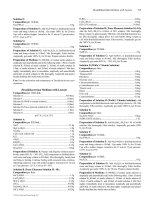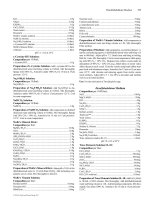Handbook of Microbiological Media, Fourth Edition part 25 ppt
Bạn đang xem bản rút gọn của tài liệu. Xem và tải ngay bản đầy đủ của tài liệu tại đây (220.28 KB, 10 trang )
Bolton Broth 235
ACES buffer (2-[(2-amino-2-oxoethyl)-
amino]-ethane sulfonic acid) 10.0g
Charcoal, activated 2.0g
α-Ketoglutarate 1.0g
Fe
4
(P
2
O
7
)
3
·9H
2
O 0.25g
Antibiotic inhibitor 10.0mL
L-Cysteine·HCl·H
2
O solution 10.0mL
pH 6.9 ± 0.2 at 25°C
Antibiotic Inhibitor:
Composition
per 10.0mL:
Anisomycin 0.08g
Cefamandole 4.0mg
Polymyxin B 80,000U
Preparation of Antibiotic Inhibitor: Add components to dis-
tilled/deionized water and bring volume to 10.0mL. Mix thoroughly.
Filter sterilize.
L-Cysteine·HCl·H
2
O Solution:
Composition
per 10.0mL:
L-Cysteine·HCl·H
2
O 0.4g
Preparation of L-Cysteine·HCl·H
2
O Solution: Add L-
cysteine·HCl·H
2
O to distilled/deionized water and bring volume to
10.0mL. Mix thoroughly. Filter sterilize.
Preparation of Medium: Add components, except antibiotic inhib-
itor and L-cysteine·HCl·H
2
O solution , to distilled/deionized water and
bring volume to 980.0mL. Mix thoroughly. Adjust medium to pH 6.9
with 1N KOH. Heat gently and bring to boiling for 1 min. Autoclave
for 15 min at 15 psi pressure–121°C. Cool to 50°–55°C. Add 10.0mL
of the sterile
L-cysteine·HCl·H
2
O solution and 10.0mL of the sterile
antibiotic solution. Mix thoroughly. Pour into sterile Petri dishes with
constant agitation to keep charcoal in suspension.
Use: For the selective isolation and cultivation of Legionella pneumophila
and other Legionella species.
BMS Agar
Composition per liter:
Agar 20.0g
L-Malic acid 2.5g
Sucrose 2.5g
KOH 2.0g
Potato extract solution 950.0mL
Bromthymol Blue 1.0mL
Vitamin solution 1.0mL
pH 7.0 ± 0.2 at 25°C
Potato Extract Solution:
Composition per liter:
Potatoes, washed, peeled, and sliced 200.0g
Preparation of Potato Extract Solution: Wash, peel, and slice
several large potatoes. Place the poltato slices in a gauze bag. Place the
bag with the potatoes in 1.0L of distilled/deionized water. Boil for 30
min. Filter through cotton.
Bromthymol Blue Solution:
Composition per 100.0mL:
Bromthymol Blue 0.5g
Ethanol, 95% 100.0mL
Preparation of Bromthymol Blue Solution: Add Bromthymol
Blue to 100.0mL of 95% ethanol. Mix thorougly.
Vitamin Solution:
Composition per 100.0mL:
Biotin 10.0g
Pyridoxine 20.0mg
Preparation of Vitamin Solution: Add components to distilled/
deionized water and bring volume to 100.0mL. Mix thoroughly. Filter
sterilize.
Preparation of Medium: Dissolve 2.5g of L-malic acid in 50.0mL of
distilled/deionized water. Add 1.0mL of Bromthymol Blue solution. Ad-
just pH to 7.0 by adding KOH so that the solution is green. Add 950.0mL
of potato extract solution. Mix thoroughly. Add 20.0g of agar and 2.5g of
sucrose. Mix thoroughly. Gently heat and bring to boiling. Autoclave for
15 min at 15 psi pressure–121°C. Cool to 50°–55°C. Aseptically add
1.0mL of sterile vitamin solution. Mix thoroughly. Pour into sterile Petri
dishes or distribute into sterile tubes.
Use: For the cultivation and maintenance of Azospirillum lipoferum.
BNS
See: Benzoate Nitrate Salts Medium
Bogoriella Medium
(DSMZ Medium 785)
Composition per liter:
NaCl 40.0g
Na
2
CO
3
10.0g
Glucose 10.0g
Peptone 5.0g
Yeast extract 5.0g
KH
2
PO
4
1.0g
MgSO
4
·7H
2
O 0.2g
pH 9.6 ± 0.2 at 25°C
Preparation of Medium: Add components to distilled/deionized
water and bring volume to 1.0L. Mix thoroughly. Distribute into tubes
or flasks. Autoclave for 15 min at 15 psi pressure–121°C.
Use: For the cultivation of Bogoriella caseilytica.
Bolton Broth
Composition per 505mL:
Bolton selective enrichment broth base 500.0mL
Horse blood, lysed 25.0mL
Bolton selective supplement soution 5.0mL
pH 7.4 ± 0.2 at 25°C
Bolton Selective Enrichment Broth Base:
Composition
per liter:
Peptone 10.0g
Lactalbumin hydrolysate 5.0g
Yeast extract 5.0g
NaCl 5.0g
α-Ketoglutarate 1.0g
Na-pyruvate 0.5g
Na-metabisulfite 0.5g
Na
2
CO
3
0.6g
Hemin 0.01g
Preparation of Bolton Selective Enrichment Broth Base:
Add components to distilled/deionized water and bring volume to
1.0L. Mix thoroughly. Autoclave for 15 min at 15 psi pressure–121°C.
Cool to 50°C.
© 2010 by Taylor and Francis Group, LLC
236 Bonner-Addicott Medium
Bolton Broth Supplement Solution:
Composition
per 5.0mL
Vancomycin 10.0mg
Cefoperazone 10.0mg
Trimethoprim 10.0mg
Cycloheximide 10.0mg
Ethanol 2.5mL
Preparation of Bolton Supplement Solution: Add antibiotics to
2.5mL ethanol. Mix thoroughly. Bring volume to 5.0mL with distilled/
deionized water. Mix thoroughly. Filter sterilize.
Caution: Cycloheximide is toxic. Avoid skin contact or aerosol for-
mation and inhalation.
Preparation of Medium: Aseptically combine 500.0mL warm
Bolton selective enrichment broth base, 25.0mL lysed horse blood, and
5.0mL Bolton slective supplement soution.
Use: For the enrichment of Campylobacter spp. from foods.
Bonner-Addicott Medium
Composition per liter:
Agar 25.0g
Glucose 20.0g
Ca(NO
3
)
2
·4H
2
O 0.236g
KNO
3
0.081g
KCl 0.065g
MgSO
4
·7H
2
O 0.036g
KH
2
PO
4
0.012g
Ferric tartrate 1.0mg
Preparation of Medium: Add components to distilled/deionized
water and bring volume to 1.0L. Mix thoroughly. Gently heat and bring
to boiling. Distribute into tubes or flasks. Autoclave for 15 min at 15
psi pressure–121°C. Pour into sterile Petri dishes or leave in tubes.
Use: For the cultivation of a variety of fungi.
Bordetella pertussis Selective Medium
with Bordet-Gengou Agar Base
Composition per 1210.0mL:
Bordet-Gengou agar base 1.0L
Horse blood, defibrinated 200.0mL
Cephalexin solution 10.0mL
pH 6.7± 0.2 at 25°C
Source: This medium is available as a premixed powder from Oxoid
Unipath.
Bordet-Gengou Agar Base:
Composition per liter:
Agar 20.0g
NaCl 5.5g
Pancreatic digest of casein 5.0g
Peptic digest of animal tissue 5.0g
Preparation of Bordet-Gengou Agar Base: Add components to
1.0L of 1% glycerol solution. Autoclave for 15 min at 15 psi pressure–
121°C. Cool to 50°C.
Cephalexin Solution:
Composition
per 10.0mL:
Cephalexin 0.04g
Preparation of Cephalexin Solution: Add cephalexin to dis-
tilled/deionized water and bring volume to 10.0mL. Mix thoroughly.
Filter sterilize.
Preparation of Medium: Aseptically add 10.0mL of sterile ce-
phalexin solution and 200.0mL of defibrinated horse blood to 1.0L
Bordet-Gengou agar base. Mix thoroughly and pour into sterile Petri
dishes.
Use: For the selective isolation and presumptive identification of Bor-
detella pertussis and Bordetella parapertussis. Bordetella pertussis
appears as small, nearly transparent, “bisected pearl-like” colonies.
Bordetella pertussis Selective Medium with Charcoal
Agar Base
Composition per 1110.0mL:
Charcoal agar base 1.0L
Horse blood, defibrinated 100.0mL
Cephalexin solution 10.0mL
pH 6.7± 0.2 at 25°C
Source: This medium is available as a premixed powder from Oxoid
Unipath.
Charcoal Agar Base:
Composition
per liter:
Agar 12.0g
Beef extract 10.0g
Starch 10.0g
NaCl 5.0g
Pancreatic digest of casein 5.0g
Peptic digest of animal tissue 5.0g
Charcoal 4.0g
Nicotinic acid 1.0mg
Preparation of Charcoal Agar Base: Add components of char-
coal agar base to distilled/deionized water and bring volume to 1.0L.
Autoclave for 15 min at 15 psi pressure–121°C. Cool to 50°C.
Cephalexin Solution:
Composition
per 10.0mL:
Cephalexin 0.04g
Preparation of Cephalexin Solution: Add cephalexin to dis-
tilled/deionized water and bring volume to 10.0mL. Mix thoroughly.
Filter sterilize.
Preparation of Medium: Aseptically add 10.0mL of sterile ce-
phalexin solution and 100.0mL of defibrinated horse blood to charcoal
agar base. Mix thoroughly and pour into sterile Petri dishes.
Use: For the selective isolation and presumptive identification of Bor-
detella pertussis and Bordetella parapertussis. Bordetella pertussis
appears as small, pale, shiny colonies.
Bordet-Gengou Agar
Composition per liter:
Agar 20.0g
Glycerol 10.0g
NaCl 5.5g
Pancreatic digest of casein 5.0g
Peptic digest of animal tissue 5.0g
Potato, solids from infusion 4.5g
Rabbit blood 200.0mL
pH 6.7± 0.2 at 25°C
© 2010 by Taylor and Francis Group, LLC
Bordet-Gengou HiVeg Agar Base with Rabbit Blood and Glycerol 237
Source: This medium is available as a premixed powder from Oxoid
Unipath and BD Diagnostic Systems.
Preparation of Medium: Add 10.0g of glycerol to 980.0mL of dis-
tilled/deionized water. Add other components, except rabbit blood, to
the glycerol solution. Mix thoroughly. Heat with occasional agitation
of the medium. Boil for 1 min. Autoclave for 15 min at 15 psi pressure–
121°C. Cool medium to 50°C. Aseptically add 200.0mL of rabbit
blood (prewarmed to 35°C) to a concentration of 15–30%. 150.0–
200.0mL of sterile, defibrinated horse blood may be used in place of
rabbit blood. Mix thoroughly and pour plates or prepare slants.
Use: For the detection and isolation of Bordetella pertussis and Bor-
detella parapertussis from clinical specimens. The medium is rendered
selective by the addition of methicillin. Bordetella pertussis appears as
small (<1mm), smooth, pearl-like colonies surrounded by a narrow
zone of hemolysis. Bordetella parapertussis appears as brown, non-
shiny colonies with a green-black coloration on the reverse side. Bor-
detella bronchiseptica appears as brown, nonshiny, moderately
sized colonies with a roughly pitted surface.
Bordet-Gengou Agar Base
with Rabbit Blood and Glycerol
Composition per liter:
Potatoes, infusion from 125.0g
Agar 20.0g
Peptic digest of animal tissue 10.0g
NaCl 5.5g
Rabbit blood 200.0mL
Glycerol 10.0mL
pH 6.7± 0.2 at 25°C
Source: This medium without glycerol and blood is available as a pre-
mixed powder from HiMedia.
Preparation of Medium: Add 10.0g of glycerol to 790.0mL of dis-
tilled/deionized water. Add other components, except rabbit blood, to
the glycerol solution. Mix thoroughly. Heat with occasional agitation
of the medium. Boil for 1 min. Autoclave for 15 min at 15 psi pressure–
121°C. Cool medium to 50°C. Aseptically add 200.0mL of rabbit
blood (prewarmed to 35°C). Note: 150.0–200.0mL of sterile, defibri-
nated horse blood may be used in place of rabbit blood. Mix thoroughly
and pour plates or prepare slants.
Use: For the detection and isolation of Bordetella pertussis and Bor-
detella parapertussis from clinical specimens. Bordetella pertussis
appears as small (<1mm), smooth, pearl-like colonies surrounded by a
narrow zone of hemolysis. Bordetella parapertussis appears as brown,
nonshiny colonies with a green-black coloration on the reverse side.
Bordetella bronchiseptica appears as brown, nonshiny, moderately
sized colonies with a roughly pitted surface.
Bordet-Gengou Agar Base with 1.6% Agar
Composition per liter:
Potatoes, infusion from 125.0g
Agar 16.0g
Peptic digest of animal tissue 10.0g
NaCl 5.5g
Rabbit blood 200.0mL
Glycerol 10.0mL
pH 6.7± 0.2 at 25°C
Source: This medium without glycerol and blood is available as a pre-
mixed powder from HiMedia.
Preparation of Medium: Add 10.0g of glycerol to 790.0mL of dis-
tilled/deionized water. Add other components, except rabbit blood, to
the glycerol solution. Mix thoroughly. Heat with occasional agitation
of the medium. Boil for 1 min. Autoclave for 15 min at 15 psi pressure–
121°C. Cool medium to 50°C. Aseptically add 200.0mL of rabbit
blood (prewarmed to 35°C). 150.0–200.0mL of sterile, defibrinated
horse blood may be used in place of rabbit blood. Mix thoroughly and
pour plates or prepare slants.
Use: For the detection and isolation of Bordetella pertussis and Bor-
detella parapertussis from clinical specimens. Bordetella pertussis
appears as small (<1mm), smooth, pearl-like colonies surrounded by a
narrow zone of hemolysis. Bordetella parapertussis appears as brown,
nonshiny colonies with a green-black coloration on the reverse side.
Bordetella bronchiseptica appears as brown, nonshiny, moderately
sized colonies with a roughly pitted surface.
Bordet-Gengou HiVeg Agar Base with 1.6% Agar
Composition per liter:
Potatoes, infusion from 125.0g
Agar 16.0g
Plant peptone 10.0g
NaCl 5.5g
Rabbit blood 200.0mL
Glycerol 10.0mL
pH 6.7± 0.2 at 25°C
Source: This medium without glycerol and blood is available as a pre-
mixed powder from HiMedia.
Preparation of Medium: Add 10.0g of glycerol to 790.0mL of dis-
tilled/deionized water. Add other components, except rabbit blood, to
the glycerol solution. Mix thoroughly. Heat with occasional agitation
of the medium. Boil for 1 min. Autoclave for 15 min at 15 psi pressure–
121°C. Cool medium to 50°C. Aseptically add 200.0mL of rabbit
blood (prewarmed to 35°C). 150.0–200.0mL of sterile, defibrinated
horse blood may be used in place of rabbit blood. Mix thoroughly and
pour plates or prepare slants.
Use: For the detection and isolation of Bordetella pertussis and Bor-
detella parapertussis from clinical specimens. Bordetella pertussis
appears as small (<1mm), smooth, pearl-like colonies surrounded by a
narrow zone of hemolysis. Bordetella parapertussis appears as brown,
nonshiny colonies with a green-black coloration on the reverse side.
Bordetella bronchiseptica appears as brown, nonshiny, moderately
sized colonies with a roughly pitted surface.
Bordet-Gengou HiVeg Agar Base
with Rabbit Blood and Glycerol
Composition per liter:
Potatoes, infusion from 125.0g
Agar 20.0g
Plant peptone 10.0g
NaCl 5.5g
Rabbit blood 200.0mL
Glycerol 10.0mL
pH 6.7± 0.2 at 25°C
Source: This medium without glycerol and blood is available as a pre-
mixed powder from HiMedia.
Preparation of Medium: Add 10.0g of glycerol to 790.0mL of dis-
tilled/deionized water. Add other components, except rabbit blood, to
the glycerol solution. Mix thoroughly. Heat with occasional agitation
of the medium. Boil for 1 min. Autoclave for 15 min at 15 psi pressure–
© 2010 by Taylor and Francis Group, LLC
238 Bordet-Gengou Medium
121°C. Cool medium to 50°C. Aseptically add 200.0mL of rabbit
blood (prewarmed to 35°C). Note: 150.0–200.0mL of sterile, defibri-
nated horse blood may be used in place of rabbit blood. Mix thoroughly
and pour plates or prepare slants.
Use: For the detection and isolation of Bordetella pertussis and Bor-
detella parapertussis from clinical specimens. Bordetella pertussis
appears as small (<1mm), smooth, pearl-like colonies surrounded by a
narrow zone of hemolysis. Bordetella parapertussis appears as brown,
nonshiny colonies with a green-black coloration on the reverse side.
Bordetella bronchiseptica appears as brown, nonshiny, moderately
sized colonies with a roughly pitted surface.
Bordet-Gengou Medium
(ATCC Medium 35)
Composition per liter:
Agar 20.0g
Glycerol 10.0g
Proteose peptone 10.0g
NaCl 5.5g
Pancreatic digest of casein 5.0g
Peptic digest of animal tissue 5.0g
Potato, solids from infusion 4.5g
Rabbit blood 150.0mL
pH 6.7± 0.2 at 25°C
Source: This medium is available as a premixed powder from Oxoid
Unipath and BD Diagnostic Systems.
Preparation of Medium: Add 10.0g of glycerol to 980.0mL of dis-
tilled/deionized water. Add other components, except rabbit blood, to
the glycerol solution. Mix thoroughly. Heat with occasional agitation
of the medium. Boil for 1 min. Autoclave for 15 min at 15 psi pressure–
121°C. Cool medium to 50°C. Aseptically add 150.0mL of rabbit
blood (prewarmed to 35°C). Mix thoroughly. Pour into sterile Petri
dishes or distribute into sterile tubes. Allow tubes to cool in a slanted
position.
Use: For the detection and isolation of Bordetella pertussis and Bor-
detella parapertussis from clinical specimens. The medium is rendered
selective by the addition of methicillin. Bordetella pertussis appears as
small (<1mm), smooth, pearl-like colonies surrounded by a narrow
zone of hemolysis. Bordetella parapertussis appears as brown, non-
shiny colonies with a green-black coloration on the reverse side. Bor-
detella bronchiseptica appears as brown, nonshiny, moderately
sized colonies with a roughly pitted surface.
Bordet-Gengou Medium
(LMG Medium 23)
Composition per liter:
Agar 20.0g
Proteose peptone 10.0g
NaCl 5.5g
Pancreatic digest of casein 5.0g
Peptic digest of animal tissue 5.0g
Potato, solids from 125g infusion 4.5g
Rabbit blood, sterile defibrinated 150.0mL
Glycerol 10.0mL
pH 6.7± 0.2 at 25°C
Preparation of Medium: Add 10.0mL of glycerol to 850.0mL of
distilled/deionized water. Add the other components, except rabbit
blood, to the glycerol solution. Mix thoroughly. Heat with occasional
agitation of the medium. Boil for 1 min. Autoclave for 15 min at 15 psi
pressure–121°C. Cool medium to 45–50°C. Aseptically add 150.0mL
of rabbit blood (prewarmed to 35°C). Mix thoroughly. Pour into sterile
Petri dishes or distribute into sterile tubes.
Use: For the detection and isolation of Pseudomonas pertucinogena.
Borrelia Medium
Composition per 370.0mL:
Solution 4 240.0mL
Solution 1 80.0mL
Solution 2 34.0mL
Rabbit serum, sterile 10.0mL
Solution 3 4.0mL
Solution 5 0.7mL
Solution 1:
Composition
per liter:
Na
2
HPO
4
·7H
2
O 26.52g
Glucose 12.75g
Proteose peptone No.2 5.95g
Pancreatic digest of casein 2.55g
NaCl 1.2g
Sodium pyruvate 1.06g
NaH
2
PO
4
·H
2
O 1.03g
KCl 0.85g
MgCl
2
·6H
2
O 0.68g
N-acetylglucosamine 0.53g
Sodium citrate·2H
2
O 0.47g
Preparation of Solution 1: Add components to distilled/deionized
water and bring volume to 1.0L. Mix thoroughly. Store at −20° C.
Solution 2:
Composition
per 100.0mL:
Bovine albumin fraction V 10.0g
Preparation of Solution 2: Add bovine albumin to distilled/deion-
ized water and bring volume to 100.0mL. Mix thoroughly. Adjust pH
to 7.8 with NaOH. Store at −20°C.
Solution 3:
Composition
per 100.0mL:
NaHCO
3
4.5g
Preparation of Solution 3: Add NaHCO
3
to distilled/deionized
water and bring volume to 100.0mL. Mix thoroughly. Prepare solution
freshly.
Solution 4:
Composition
per 100.0mL:
Gelatin 7.0g
Preparation of Solution 4: Add gelatin to distilled/deionized water
and bring volume to 100.0mL. Mix thoroughly. Autoclave for 15 min
at 10 psi pressure–115°C. Store at 4°C.
Solution 5:
Composition
per 100.0mL:
Phenol Red 0.5g
Preparation of Solution 5: Add Phenol Red to distilled/deionized
water and bring volume to 100.0mL. Mix thoroughly. Store at 4°C.
Preparation of Medium: Combine 80.0mL of solution 1, 34.0mL of
solution 2, 4.0mL of solution 3, 0.7mL of solution 5, and 1.3mL of dis-
tilled/deionized water. Mix thoroughly. Filter sterilize under pressure.
Aseptically distribute into sterile borosilicate screw-capped tubes in
6.0mL volumes. Melt solution 4 by immersing tube in warm water. Add
© 2010 by Taylor and Francis Group, LLC
Bovine Serum Albumin Tween™ 80 Broth 239
2.0mL of solution 4 to each screw-capped tube. Add 0.5mL of sterile
rabbit serum to each screw-capped tube.
Use: For the cultivation of Borrelia hermsii, Borrelia turicatae, and
Borrelia parkeri.
BOS Broth
See: Bile Oxalate Sorbose Broth
Bosea thiooxidans Medium
(DSMZ Medium 763)
Composition per liter:
Na
2
S
2
O
3
·5H
2
O 5.0g
Na-succinate 5.0g
Na
2
HPO
4
4.0g
KH
2
PO
4
1.5g
MgCl
2
0.1g
Na-glutamate 0.5g
Yeast extract 0.1g
pH 7.5–8.5 at 25°C
Preparation of Medium: Add components to distilled/deionized
water and bring volume to 1.0L. Mix thoroughly. Distribute into tubes or
flasks. Autoclave for 15 min at 15 psi pressure–121°C.
Use: For the cultivation of Bosea thiooxidans.
Botrytis Separation Agar
Composition per liter:
Agar 20.0g
Pancreatic digest of casein 5.0g
Glycerol 5.0g
NaNO
3
3.0g
Yeast extract 3.0g
Sorbose 2.5g
KCl 1.0g
MgSO
4
0.5g
KH
2
PO
4
0.15g
Preparation of Medium: Add components to distilled/deionized
water and bring volume to 1.0L. Mix thoroughly. Gently heat and bring
to boiling. Distribute into tubes or flasks. Autoclave for 15 min at 15
psi pressure–121°C. Pour into sterile Petri dishes or leave in tubes.
Use: For the cultivation and differentiation of Botrytis species. Botry-
tis cinerea will grow equally well with and without sorbose. Botrytis
alli is inhibited by sorbose.
Bouillon Medium
Composition per liter:
Peptone 15.0g
Meat extract 5.0g
NaCl 5.0g
K
2
HPO
4
5.0g
pH 7.0 ± 0.2 at 25°C
Preparation of Medium: Add components to distilled/deionized
water and bring volume to 1.0L. Mix thoroughly. Heat with frequent
agitation and bring to boiling. Distribute into tubes or flasks. Autoclave
for 15 min at 15 psi pressure–121°C.
Use: For the general cultivation of heterotrophic microorganisms.
Bovine Serum Albumin Tween™ 80 Agar
(BSA Tween™ 80 Agar)
Composition per liter:
Basal medium 900.0mL
Albumin supplement 100.0mL
Basal Medium:
Composition
per liter:
Agar 11.0g
Na
2
HPO
4
1.0g
NaCl 1.0g
KH
2
PO
4
0.3g
Glycerol (10% solution) 1.0mL
NH
4
Cl (25% solution) 1.0mL
Sodium pyruvate (10% solution) 1.0mL
Thiamine (0.5% solution 1.0mL
Preparation of Basal Medium: Add components to distilled/de-
ionized water and bring volume to 1.0L. Mix thoroughly. Adjust pH to
7.4. Autoclave for 15 min at 15 psi pressure–121°C. Cool to 25°C.
Albumin Supplement:
Composition
per 100.0mL:
Bovine albumin 10.0g
Tween
™ 80 (10% solution) 12.5mL
FeSO
4
(0.5% solution) 10.0mL
MgCl
2
–CaCl
2
solution 1.0mL
Cyanocobalamin (0.02% solution) 1.0mL
ZnSO
4
(0.4% solution) 1.0mL
Preparation of Albumin Supplement: Add components to dis-
tilled/deionized water and bring volume to 100.0mL. Mix thoroughly.
Adjust pH to 7.4. Filter sterilize.
MgCl
2
–CaCl
2
Solution:
Composition
per 100.0mL:
CaCl
2
·2H
2
O 1.5g
MgCl
2
·6H
2
O 1.5g
Preparation of MgCl
2
–CaCl
2
Solution: Add components to dis-
tilled/deionized water and bring volume to 100.0mL. Mix thoroughly.
Preparation of Medium: To 900.0mL of cooled, sterile basal me-
dium, aseptically add 100.0mL of sterile albumin supplement. Mix
thoroughly. Aseptically distribute into sterile tubes or flasks.
Use: For the cultivation and maintenance of Leptospira species.
Bovine Serum Albumin Tween™ 80 Broth
(BSA Tween™ 80 Broth)
Composition per liter:
Basal medium 900.0mL
Albumin supplement 100.0mL
pH 7.4 ± 0.2 at 25°C
Basal Medium:
Composition
per liter:
Na
2
HPO
4
1.0g
NaCl 1.0g
KH
2
PO
4
0.3g
Glycerol (10% solution) 1.0mL
NH
4
Cl (25% solution) 1.0mL
Sodium pyruvate (10% solution) 1.0mL
Thiamine (0.5% solution 1.0mL
© 2010 by Taylor and Francis Group, LLC
240 Bovine Albumin Tween™ 80 Medium, Ellinghausen and McCullough, Modified
Preparation of Basal Medium: Add components to distilled/de-
ionized water and bring volume to 1.0L. Mix thoroughly. Adjust pH to
7.4. Autoclave for 15 min at 15 psi pressure–121°C. Cool to 25°C.
Albumin Supplement:
Composition
per 100.0mL:
Bovine albumin 10.0g
Tween
™ 80 (10% solution) 12.5mL
FeSO
4
(0.5% solution) 10.0mL
MgCl
2
–CaCl
2
solution 1.0mL
Cyanocobalamin (0.02% solution) 1.0mL
ZnSO
4
(0.4% solution) 1.0mL
Preparation of Albumin Supplement: Add components to dis-
tilled/deionized water and bring volume to 100.0mL. Mix thoroughly.
Adjust pH to 7.4. Filter sterilize.
MgCl
2
–CaCl
2
Solution:
Composition
per 100.0mL:
CaCl
2
·2H
2
O 1.5g
MgCl
2
·6H
2
O 1.5g
Preparation of MgCl
2
–CaCl
2
Solution: Add components to dis-
tilled/deionized water and bring volume to 100.0mL. Mix thoroughly.
Preparation of Medium: To 900.0mL of cooled, sterile basal me-
dium, aseptically add 100.0mL of sterile albumin supplement. Mix
thoroughly. Aseptically distribute into sterile tubes or flasks.
Use: For the isolation and cultivation of Leptospira species.
Bovine Albumin Tween™ 80 Medium,
Ellinghausen and McCullough, Modified
(Albumin Fatty Acid Broth,
Leptospira Medium)
Composition per liter:
Basal medium 900.0mL
Albumin fatty acid supplement 100.0mL
Basal Medium:
Composition
per liter:
Na
2
HPO
4
, anhydrous 1.0g
NaCl 1.0g
KH
2
PO
4
, anhydrous 0.3g
NH
4
Cl (25% solution) 1.0mL
Glycerol (10% solution) 1.0mL
Sodium pyruvate (10% solution) 1.0mL
Thiamine·HCl (0.5% solution) 1.0mL
pH 7.4 ± 0.2 at 25°C
Preparation of Basal Medium: Add components to distilled/de-
ionized water and bring volume to 1.0L. Mix thoroughly. Adjust pH to
7.4. Gently heat and bring to boiling. Autoclave for 15 min at 15 psi
pressure–121°C. Cool to 25°C.
Albumin Fatty Acid Supplement:
Composition
per 200.0mL:
Bovine albumin fraction V 20.0g
Polysorbate (Tween™) 80 (10% solution) 25.0mL
FeSO
4
·7H
2
O (0.5% solution) 20.0mL
CaCl
2
·2H
2
O (1.5% solution) 2.0mL
MgCl
2
·2H
2
O (1.5% solution) 2.0mL
Vitamin B
12
(0.2% solution) 2.0mL
ZnSO
4
·7H
2
O (0.4% solution) 2.0mL
CuSO
4
·5H
2
O (0.3% solution) 0.2mL
Preparation of Albumin Fatty Acid Supplement: Add bovine
albumin to 100.0mL of distilled/deionized water. Mix thoroughly. Add
remaining components while stirring. Adjust pH to 7.4. Bring volume
to 200.0mL with distilled/deionized water. Filter sterilize. Store this
supplement at −20°C.
Preparation of Medium: Aseptically combine 100.0mL of sterile
albumin fatty acid supplement and 900.0mL of sterile basal medium.
Mix thoroughly. Aseptically distribute into sterile tubes or flasks.
Use: For the cultivation of Leptospira species.
Bovine Albumin Tween™ 80 Semisolid Medium,
Ellinghausen and McCullough, Modified
(Albumin Fatty Acid Semisolid Medium, Modified)
Composition per liter:
Basal medium 900.0mL
Albumin fatty acid supplement 100.0mL
Basal Medium:
Composition
per liter:
Agar 2.2g
Na
2
HPO
4
, anhydrous 1.0g
NaCl 1.0g
KH
2
PO
4
, anhydrous 0.3g
NH
4
Cl (25% solution) 1.0mL
Glycerol (10% solution) 1.0mL
Sodium pyruvate (10% solution) 1.0mL
Thiamine·HCl (0.5% solution) 1.0mL
pH 7.4 ± 0.2 at 25°C
Preparation of Basal Medium: Add components to distilled/de-
ionized water and bring volume to 1.0L. Mix thoroughly. Adjust pH to
7.4. Gently heat and bring to boiling. Autoclave for 15 min at 15 psi
pressure–121°C. Cool to 25°C.
Albumin Fatty Acid Supplement:
Composition
per 200.0mL:
Bovine albumin fraction V 20.0g
Polysorbate (Tween™) 80 (10% solution) 25.0mL
FeSO
4
·7H
2
O (0.5% solution) 20.0mL
CaCl
2
·2H
2
O (1.5% solution) 2.0mL
MgCl
2
·2H
2
O (1.5% solution) 2.0mL
Vitamin B
12
(0.2% solution) 2.0mL
ZnSO
4
·7H
2
O (0.4% solution) 2.0mL
CuSO
4
·5H
2
O (0.3% solution) 0.2mL
Preparation of Albumin Fatty Acid Supplement: Add bovine
albumin to 100.0mL of distilled/deionized water. Mix thoroughly. Add
remaining components while stirring. Adjust pH to 7.4. Bring volume
to 200.0mL with distilled/deionized water. Filter sterilize. Store this
supplement at −20°C.
Preparation of Medium: Aseptically combine 100.0mL of sterile
albumin fatty acid supplement and 900.0mL of sterile basal medium.
Mix thoroughly. Aseptically distribute into sterile tubes or flasks.
Use: For the cultivation of Leptospira species.
Bovine Serum Albumin Tween™ 80 Soft Agar
(BSA Tween™ 80 Soft Agar)
(Semisolid BSA Tween™ 80 Medium)
Composition per liter:
Basal medium 900.0mL
Albumin supplement 100.0mL
© 2010 by Taylor and Francis Group, LLC
BPL Agar 241
Basal Medium:
Composition
per liter:
Agar 2.0g
Na
2
HPO
4
1.0g
NaCl 1.0g
KH
2
PO
4
0.3g
Glycerol (10% solution) 1.0mL
NH
4
Cl (25% solution) 1.0mL
Sodium pyruvate (10% solution) 1.0mL
Thiamine (0.5% solution) 1.0mL
Preparation of Basal Medium: Add components to distilled/de-
ionized water and bring volume to 1.0L. Mix thoroughly. Adjust pH to
7.4. Autoclave for 15 min at 15 psi pressure–121°C. Cool to 25°C.
Albumin Supplement:
Composition
per 100.0mL:
Bovine albumin 10.0g
Tween
™ 80 (10% solution) 12.5mL
FeSO
4
(0.5% solution) 10.0mL
CaCl
2
–MgCl
2
solution 1.0mL
Cyanocobalamin (0.02% solution) 1.0mL
ZnSO
4
(0.4% solution) 1.0mL
Preparation of Albumin Supplement: Add components to dis-
tilled/deionized water and bring volume to 100.0mL. Mix thoroughly.
Adjust pH to 7.4. Filter sterilize.
CaCl
2
–MgCl
2
Solution:
Composition
per 100.0mL:
CaCl
2
·2H
2
O 1.5g
MgCl
2
·6H
2
O 1.5g
Preparation of CaCl
2
–MgCl
2
Solution: Add components to dis-
tilled/deionized water and bring volume to 100.0mL. Mix thoroughly.
Preparation of Medium: To 900.0mL of cooled, sterile basal me-
dium, aseptically add 100.0mL of sterile albumin supplement. Mix
thoroughly. Aseptically distribute into sterile tubes or flasks.
Use: For the cultivation of Leptospira species.
BPHD Medium
(DSMZ Medium 738)
Composition per liter:
NH
4
Cl 1.0g
Na
2
HPO
4
·2H
2
O 0.42g
Na
2
H
2
PO
4
·H
2
O 0.18g
MgCl
2
·6H
2
O 0.1g
CaCl
2
·2H
2
O 0.1g
KCl 0.1g
FeSO
4
·7H
2
O 0.04g
Phenol solution 20.0mL
Vitamin solution 10.0mL
Trace elements solution 10.0mL
pH 6.5 ± 0.2 at 25°C
Trace Elements Solution:
Composition
per liter:
MgSO
4
·7H
2
O 3.0g
Nitrilotriacetic acid 1.5g
NaCl 1.0g
MnSO
4
·2H
2
O 0.5g
CoSO
4
·7H
2
O 0.18g
ZnSO
4
·7H
2
O 0.18g
CaCl
2
·2H
2
O 0.1g
FeSO
4
·7H
2
O 0.1g
NiCl
2
·6H
2
O 0.025g
KAl(SO
4
)
2
·12H
2
O 0.02g
H
3
BO
3
0.01g
Na
2
MoO
4
·4H
2
O 0.01g
CuSO
4
·5H
2
O 0.01g
Na
2
SeO
3
·5H
2
O 0.3mg
Preparation of Trace Elements Solution: Add nitrilotriacetic
acid to 500.0mL of distilled/deionized water. Dissolve by adjusting pH
to 6.5 with KOH. Add remaining components. Add distilled/deionized
water to 1.0L. Mix thoroughly.
Vitamin Solution:
Composition
per liter:
Pyridoxine-HCl 10.0mg
Thiamine-HCl·2H
2
O 5.0mg
Riboflavin 5.0mg
Nicotinic acid 5.0mg
D-Ca-pantothenate 5.0mg
p-Aminobenzoic acid 5.0mg
Lipoic acid 5.0mg
Biotin 2.0mg
Folic acid 2.0mg
Vitamin B
12
0.1mg
Preparation of Vitamin Solution: Add components to distilled/
deionized water and bring volume to 1.0L. Mix thoroughly. Filter ster-
ilize.
Phenol Solution:
Composition
per liter:
Phenol 4.7g
Preparation of Phenol Solution: Add phenol to distilled/deion-
ized water and bring volume to 1.0L. Mix thoroughly. Filter sterilize.
Preparation of Medium: Add components, except phenol solution
and vitamin solution, to distilled/deionized water and bring volume to
970.0mL. Mix thoroughly. Adjust pH to 6.5. Autoclave for 15 min at 15
psi pressure–121°C. Aseptically add 20.0mL phenol solution and
10.0mL vitamin solution. Mix thoroughly. Aseptically distribute into
sterile tubes or bottles.
Use: For the cultivation of Bacillus sp.
BPL Agar
(Brilliant Green Phenol Red Agar)
Composition per liter:
Lactose 15.0g
Agar 13.0g
NaCl 5.0g
Meat peptone 7.0g
Phenol Red 0.04g
Brilliant Green 5.0mg
pH 6.5 ± 0.2 at 25°C
Source: This medium is available as a premixed powder from Hi-
Media.
Preparation of Medium: Add components to distilled/deionized
water and bring volume to 1.0L. Mix thoroughly. Gently heat and bring
to boiling. Distribute into tubes or flasks. Autoclave for 15 min at 15
psi pressure–121°C. Pour into sterile Petri dishes or leave in tubes.
Use: For the cultivation of Salmonella species, with the exception of
S. typhi, from feces, urine, meat, milk, and other materials.
© 2010 by Taylor and Francis Group, LLC
242 BPL HiVeg Agar
BPL HiVeg Agar
(Brilliant Green Phenol Red HiVeg Agar)
Composition per liter:
Lactose 15.0g
Agar 13.0g
Plant peptone No. 1 7.0g
NaCl 5.0g
Phenol Red 0.04g
Brilliant Green 5.0mg
pH 6.5 ± 0.2 at 25°C
Source: This medium is available as a premixed powder from Hi-
Media.
Preparation of Medium: Add components to distilled/deionized
water and bring volume to 1.0L. Mix thoroughly. Gently heat and bring
to boiling. Distribute into tubes or flasks. Autoclave for 15 min at 15
psi pressure–121°C. Pour into sterile Petri dishes or leave in tubes.
Use: For the cultivation of Salmonella species, with the exception of
S. typhi, from feces, urine, meat, milk and other materials.
B.Q.Vaccine Medium HiVeg with Glucose
(Thioglycollate Broth with Plant Extract No. 2)
Composition per liter:
Plant peptone 10.0g
Plant extract No. 2 5.0g
Plant infusion 5.0g
NaCl 5.0g
K
2
HPO
4
4.0g
Na-thioglycollate 1.0g
Glucose solution 50.0mL
pH 8.2 ± 0.2 at 25°C
Source: This medium without glucose solution is available as a pre-
mixed powder from HiMedia.
Glucose Solution:
Composition
per 100.0mL:
Glucose 20.0g
Preparation of Glucose Solution: Add glucose to distilled/deion-
ized water and bring volume to 100.0mL. Mix thoroughly. Filter ster-
ilize.
Preparation of Medium: Add components, except glucose solu-
tion, to distilled/deionized water and bring volume to 950.0mL. Mix
thoroughly. Autoclave for 15 min at 15 psi pressure–121°C. Aseptical-
ly add 50.0mL of sterile glucose solution. Mix thoroughly. Aseptically
distribute into sterile tubes or flasks.
Use: For the cultivation of anaerobic organisms on a large scale.
B.Q.Vaccine Medium with Glucose
(Thioglycollate Broth with Liver Extract)
Composition per liter:
Liver tissues 250.0g
Muscle tissues 250.0g
Peptic digest of animal tissue 10.0g
NaCl 5.0g
K
2
HPO
4
4.0g
Na-thioglycollate 1.0g
Glucose solution 50.0mL
pH 8.2 ± 0.2 at 25°C
Source: This medium without glucose solution is available as a pre-
mixed powder from HiMedia.
Glucose Solution:
Composition
per 100.0mL:
Glucose 20.0g
Preparation of Glucose Solution: Add glucose to distilled/deion-
ized water and bring volume to 100.0mL. Mix thoroughly. Filter ster-
ilize.
Preparation of Medium: Add components, except glucose solu-
tion, to distilled/deionized water and bring volume to 950.0mL. Mix
thoroughly. Autoclave for 15 min at 15 psi pressure–121°C. Aseptical-
ly add 50.0mL of sterile glucose solution. Mix thoroughly. Aseptically
distribute into sterile tubes or flasks.
Use: For the cultivation of anaerobic organisms on a large scale.
Brackish Acetate
Composition per liter:
Sodium acetate 1.0g
KNO
3
1.0g
NaH
2
PO
4
·2H
2
O 0.05g
Artificial seawater 250.0mL
Modified Hutner’s basal salts 20.0mL
Vitamin solution 10.0mL
pH 7.2 ± 0.2 at 25°C
Artificial Seawater:
Composition
per liter:
NaCl 23.5g
MgCl
2
5.0g
Na
2
SO
4
3.9g
CaCl
2
1.1g
KCl 0.66g
NaHCO
3
0.19g
KBr 0.1g
H
3
BO
3
0.026g
SrCl
2
0.024g
NaF 3.0mg
Preparation of Artificial Seawater: Add components to distilled/
deionized water and bring volume to 100.0mL. Mix thoroughly.
Modified Hutner’s Basal Salts:
Composition
per liter:
MgSO
4·
7H
2
O 29.7g
Nitrilotriacetic acid 10.0g
CaCl
2
·2H
2
O 3.34g
FeSO
4
·7H
2
O 0.1g
(NH
4
)
2
MoO
4
9.25mg
Metals “44” 50.0mL
Preparation of Modified Hutner’s Basal Salts: Dissolve the
nitrilotriacetic acid first and neutralize the solution with KOH. Add the
other components and adjust the pH to 7.2 with KOH or H
2
SO
4
. There
may be a slight precipitate. Store at 5°C.
Metals “44”:
Composition
per 100.0mL:
ZnSO
4
·7H
2
O 1.1g
FeSO
4
·7H
2
O 0.5g
EDTA 0.25g
MnSO
4
·7H
2
O 0.154g
CuSO
4
·5H
2
O 0.04g
© 2010 by Taylor and Francis Group, LLC
Brackish Water Ameba Medium 243
Co(NO
3
)
2
·6H
2
O 0.025g
Na
2
B
4
O
7
·10H
2
O 0.018g
Preparation of Metals “44”: Add components to distilled/deion-
ized water and bring volume to 100.0mL. Mix thoroughly. Autoclave
for 15 min at 15 psi pressure–121°C. Add aseptically to sterile basal
medium.
Vitamin Solution:
Composition
per liter:
Thiamine·HCl 5.0mg
D-Calcium pantothenate 5.0mg
Riboflavin 5.0mg
Biotin 2.0mg
Folic acid 2.0mg
Vitamin B
12
0.1mg
Preparation of Vitamin Solution: Add components to distilled/
deionized water and bring volume to 1.0L. Mix thoroughly. Filter ster-
ilize and add aseptically to sterile basal medium.
Preparation of Medium: Add a few drops of H
2
SO
4
to the distilled
water to retard precipitation of the metal salts. Add components, except
for Metals “44” and vitamin solutions to 250.0mL of artificial seawater
and 720.0mL of distilled/deionized water. Adjust pH to 7.2. Distribute
into tubes or flasks. Sterilize by autoclaving for 15 min at 15 psi pres-
sure–121°C. Aseptically add Metals “44” and vitamin solution. Mix
thoroughly. Aseptically distribute into sterile tubes or flasks.
Use: For the cultivation of Filomicrobium fusiforme.
Brackish Prosthecomicrobium Medium
Composition per liter:
Agar 15.0g
Peptone 0.25g
Yeast extract 0.25g
Glucose 0.25g
Artificial seawater 250.0mL
Modified Hutner’s basal salts 20.0mL
Vitamin solution 10.0mL
pH 7.2 ± 0.2 at 25°C
Artificial Seawater:
Composition
per liter:
NaCl 23.477g
MgCl
2
4.981g
Na
2
SO
4
3.917g
CaCl
2
1.102g
KCl 0.664g
NaHCO
3
0.192g
KBr 0.096g
H
3
BO
3
0.026g
SrCl
2
0.024g
NaF 3.0mg
Preparation of Artificial Seawater: Add components to distilled/
deionized water and bring volume to 100.0mL. Mix thoroughly.
Modified Hutner’s Basal Salts:
Composition
per liter:
MgSO
4·
7H
2
O 29.7g
Nitrilotriacetic acid 10.0g
CaCl
2
·2H
2
O 3.34g
FeSO
4
·7H
2
O 0.1g
(NH
4
)
2
MoO
4
9.25mg
Metals “44” 50.0mL
Preparation of Modified Hutner’s Basal Salts: Dissolve the
nitrilotriacetic acid first and neutralize the solution with KOH. Add the
other ingredients and readjust the pH with KOH and/or H
2
SO
4
to 7.2.
There may be a slight precipitate. Store at 5°C.
Metals “44”:
Composition
per 100.0mL:
ZnSO
4
·7H
2
O 1.1g
FeSO
4
·7H
2
O 0.5g
EDTA 0.25g
MnSO
4
·7H
2
O 0.154g
CuSO
4
·5H
2
O 0.04g
Co(NO
3
)
2
·6H
2
O 0.025g
Na
2
B
4
O
7
·10H
2
O 0.018g
Preparation of Metals “44”: Add components to distilled/deion-
ized water and bring volume to 100.0mL. Mix thoroughly. Autoclave
for 15 min at 15 psi pressure–121°C. Add aseptically to sterile basal
medium.
Vitamin Solution:
Composition
per liter:
Thiamine·HCl 5.0mg
D-Calcium pantothenate 5.0mg
Riboflavin 5.0mg
Biotin 2.0mg
Folic acid 2.0mg
Vitamin B
12
0.1mg
Preparation of Vitamin Solution: Add components to distilled/
deionized water and bring volume to 1.0L. Mix thoroughly. Filter ster-
ilize and add aseptically to sterile basal medium.
Preparation of Medium: Add a few drops of H
2
SO
4
to the distilled
water to retard precipitation of the metal salts. Add components, except
Metals “44” and vitamin solution, to 250.0mL of artificial seawater and
720.0mL of distilled/deionized water. Adjust pH to 7.2. Distribute into
tubes or flasks. Sterilize by autoclaving for 15 min at 15 psi pressure–
121°C. Aseptically add Metals “44” and vitamin solution. Mix thor-
oughly. Aseptically distribute into sterile tubes or flasks.
Use: For the cultivation of Prosthecomicrobium litoralum.
Brackish Water Ameba Medium
Composition per liter:
Agar 10.0g
Malt extract 0.1g
Yeast extract 0.1g
Artificial seawater 167.0mL
Artificial Seawater:
Composition
per liter:
NaCl 27.5g
MgCl
2
·6H
2
O 5.38g
MgSO
4
·7H
2
O 6.78g
KCl 0.72g
NaHCO
3
0.2g
CaCL
2
·2H
2
O 1.4g
Preparation of Artificial Seawater: Add components to distilled/
deionized water and bring volume to 1.0L. Mix thoroughly.
Preparation of Medium: Add components to distilled/deionized
water and bring volume to 1.0L. Mix thoroughly. Gently heat and bring
to boiling. Distribute into tubes or flasks. Autoclave for 15 min at 15
psi pressure–121°C. Pour into sterile Petri dishes or leave in tubes.
Use: For the cultivation of Flabellula hoguae.
© 2010 by Taylor and Francis Group, LLC
244 Brain Heart CC Agar
Brain Heart CC Agar
(Brain Heart Cycloheximide Chloramphenicol Agar)
Composition per liter:
Pancreatic digest of casein 16.0g
Agar 13.5g
Brain heart, solids from infusion 8.0g
Peptic digest of animal tissue 5.0g
NaCl 5.0g
Na
2
HPO
4
2.5g
Glucose 2.0g
Cycloheximide 0.5g
Chloramphenicol 0.05g
pH 7.4 ± 0.2 at 25°C
Source: This medium is available as a premixed powder from BD Di-
agnostic Systems.
Caution: Cycloheximide is toxic. Avoid skin contact or aerosol for-
mation and inhalation.
Preparation of Medium: Add components to distilled/deionized
water and bring volume to 1.0L. Mix thoroughly. Distribute into tubes
or flasks while shaking to distribute precipitate. Autoclave for 15 min
at 15 psi pressure–118°C.
Use: For the selective isolation of fastidious pathogenic fungi such as
Histoplasma capsulatum and Blastomyces dermatiditis from speci-
mens heavily contaminated with bacteria and other fungi. It may also
be used as a base supplemented with sheep blood and gentamicin for
enrichment and additional selectivity.
Brain Heart CC Agar, HiVeg
(Brain Heart Cycloheximide
Chloramphenicol Agar, HiVeg)
Composition per liter:
Agar 15.0g
Plant infusion 10.0g
Plant peptone No. 3 10.0g
Plant special infusion 7.5g
NaCl 5.0g
Na
2
HPO
4
2.5g
Glucose 2.0g
Cycloheximide 0.5g
Chloramphenicol 0.05g
pH 7.4 ± 0.2 at 25°C
Source: This medium is available as a premixed powder from Hi-
Media.
Caution: Cycloheximide is toxic. Avoid skin contact or aerosol for-
mation and inhalation.
Preparation of Medium: Add components to distilled/deionized
water and bring volume to 1.0L. Mix thoroughly. Distribute into tubes
or flasks while shaking to distribute precipitate. Autoclave for 15 min
at 15 psi pressure–118°C.
Use: For the selective isolation of fastidious pathogenic fungi such as
Histoplasma capsulatum and Blastomyces dermatiditis from speci-
mens heavily contaminated with bacteria and other fungi. This medium
may also be used as a base supplemented with sheep blood and gentam-
icin for enrichment and additional selectivity.
Brain Heart Infusion
See: BHI
Brain Heart Infusion
(BHI)
Composition per liter:
Pancreatic digest of gelatin 14.5g
Brain heart, solids from infusion 6.0g
Peptic digest of animal tissue 6.0g
NaCl 5.0g
Glucose 3.0g
Na
2
HPO
4
2.5g
pH 7.4 ± 0.2 at 25°C
Source: This medium is available as a premixed powder from Oxoid
Unipath and BD Diagnostic Systems.
Preparation of Medium: Add components to distilled/deionized
water and bring volume to 1.0L. Mix thoroughly. Distribute into tubes
or flasks. Autoclave for 15 min at 15 psi pressure–121°C.
Use: For the cultivation of fastidious and nonfastidious microorganisms,
including aerobic and anaerobic bacteria, from a variety of clinical and
nonclinical specimens. It is particularly useful for culturing streptococci,
pneumococci, and meningococci. It is also used for the preparation of
inocula for use in antimicrobial susceptibility tests and as a base for blood
culture.
Brain Heart Infusion Agar
(BHI Agar)
Composition per liter:
Beef heart infusion 250.0g
Calf brain infusion 200.0g
Agar 13.5g
Proteose peptone 10.0g
NaCl 5.0g
Na
2
HPO
4
·12H
2
O 2.5g
Glucose 2.0g
pH 7.4 ± 0.2 at 25°C
Preparation of Medium: Add components to distilled/deionized
water and bring volume to 1.0L. Mix thoroughly. Gently heat and bring
to boiling. Distribute into tubes or flasks. Autoclave for 15 min at 15
psi pressure–121°C. Pour into sterile Petri dishes or leave in tubes.
Use: For the cultivation of a variety of fastidious and nonfastidious aer-
obic and anaerobic microorganisms.
Brain Heart Infusion Agar
Composition per liter:
Pancreatic digest of casein 16.0g
Agar 13.5g
Brain heart, solids from infusion 8.0g
Peptic digest of animal tissue 5.0g
NaCl 5.0g
Glucose 2.0g
Na
2
HPO
4
2.5g
pH 7.4 ± 0.2 at 25°C
Source: This medium is available as a premixed powder from Oxoid
Unipath and BD Diagnostic Systems.
Preparation of Medium: Add components to distilled/deionized
water and bring volume to 1.0L. Mix thoroughly. Distribute into tubes
or flasks while shaking to distribute precipitate. Autoclave for 15 min
at 15 psi pressure–121°C.
© 2010 by Taylor and Francis Group, LLC
